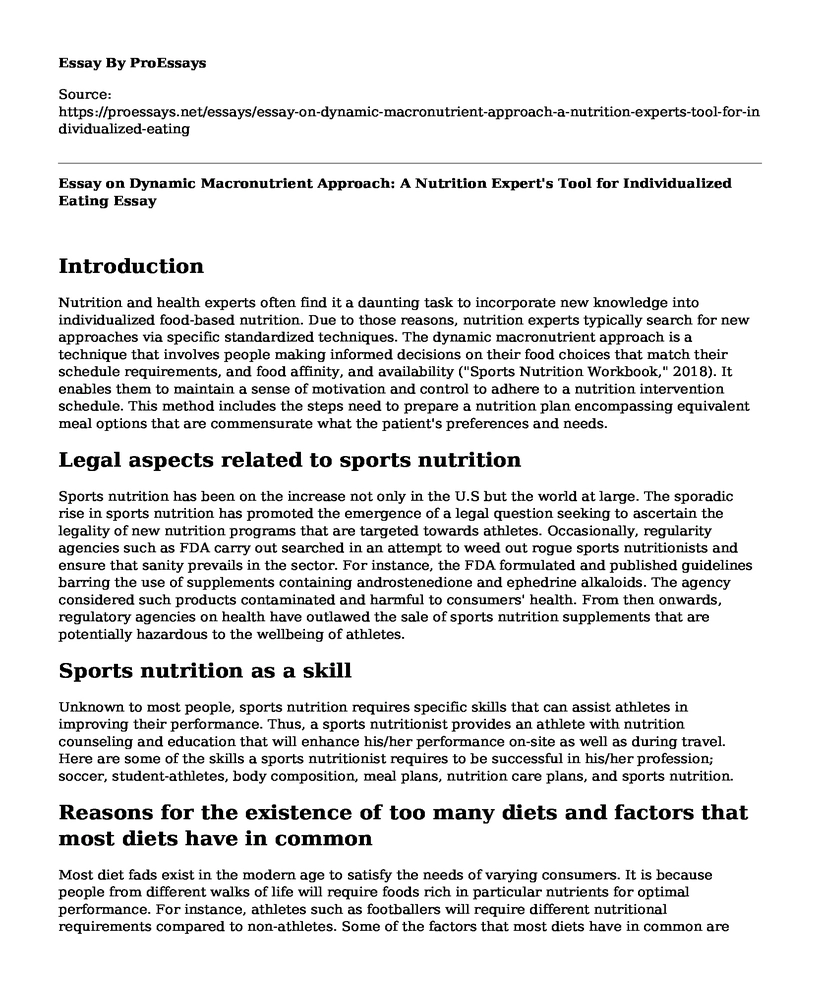Introduction
Nutrition and health experts often find it a daunting task to incorporate new knowledge into individualized food-based nutrition. Due to those reasons, nutrition experts typically search for new approaches via specific standardized techniques. The dynamic macronutrient approach is a technique that involves people making informed decisions on their food choices that match their schedule requirements, and food affinity, and availability ("Sports Nutrition Workbook," 2018). It enables them to maintain a sense of motivation and control to adhere to a nutrition intervention schedule. This method includes the steps need to prepare a nutrition plan encompassing equivalent meal options that are commensurate what the patient's preferences and needs.
Legal aspects related to sports nutrition
Sports nutrition has been on the increase not only in the U.S but the world at large. The sporadic rise in sports nutrition has promoted the emergence of a legal question seeking to ascertain the legality of new nutrition programs that are targeted towards athletes. Occasionally, regularity agencies such as FDA carry out searched in an attempt to weed out rogue sports nutritionists and ensure that sanity prevails in the sector. For instance, the FDA formulated and published guidelines barring the use of supplements containing androstenedione and ephedrine alkaloids. The agency considered such products contaminated and harmful to consumers' health. From then onwards, regulatory agencies on health have outlawed the sale of sports nutrition supplements that are potentially hazardous to the wellbeing of athletes.
Sports nutrition as a skill
Unknown to most people, sports nutrition requires specific skills that can assist athletes in improving their performance. Thus, a sports nutritionist provides an athlete with nutrition counseling and education that will enhance his/her performance on-site as well as during travel. Here are some of the skills a sports nutritionist requires to be successful in his/her profession; soccer, student-athletes, body composition, meal plans, nutrition care plans, and sports nutrition.
Reasons for the existence of too many diets and factors that most diets have in common
Most diet fads exist in the modern age to satisfy the needs of varying consumers. It is because people from different walks of life will require foods rich in particular nutrients for optimal performance. For instance, athletes such as footballers will require different nutritional requirements compared to non-athletes. Some of the factors that most diets have in common are that low refined carbs low added sugar and high amounts of vegetables and fiber.
Limitations of the research study
Research studies face a plethora of limitations. Some of them include sample size, lack of reliable data, lack of prior research on the topic, and inferior data collection methods. Other limitations that might crop up during a research study are limited access to data, documents, and participants. Also, a researcher may be limited by longitudinal effects as well as cultural bias.
ISSA's 1-2-3 eating rule of thumb
Although several techniques that can be used to determine nutritional ratios exist, the ISSA 1-2-3 eating rule of thumb is the most common. An individual can quickly determine the ratio he/she needs if he/she knows the number of calories required.
Calculation Method
It means that your meals will consist of 1 part fats, two parts protein, and three parts carbohydrates. Let's take a look at our example athlete, who burns off about 3,420 calories a day. The 1-2-3 part explains that there are six parts to the diet, 1+2+3 added together equals 6. The formula is 3,420 divided by 6. Example 3,420/6= 570 calories. 1 part fats equals 570 calories 2 part proteins equals 570 x2, which is 1,140 calories 3 parts carbohydrates equals 570 x 3, which is 1,710 calories. This breaks it up for you exactly how many calories you would need of all three nutrients.
Concept of nutrition conditioning
Various factors underpin nutrition conditioning. They include meeting the required energy needs, hydration, frequently eating mainly five to six small portions daily, pre-re fuelling, consumption of a balanced diet, and lastly, food first supplementation.
11 step approach for designing a healthy nutrition plan
There are crucial steps that must be followed when formulating a nutrition plan. The first step involves gathering and synthesizing information on the situation of nutrition. The second step is the determination of initial program objectives, while step three is reviewing nutrition and health services. Step 4 is the preliminary program design, and the last step involves compiling all the above steps together.
References
Sports nutrition workbook. (2018). Sports Nutrition Workbook and Study Guide. Carpentaria: The International Sports Sciences Association.
Cite this page
Essay on Dynamic Macronutrient Approach: A Nutrition Expert's Tool for Individualized Eating. (2023, Jul 18). Retrieved from https://proessays.net/essays/essay-on-dynamic-macronutrient-approach-a-nutrition-experts-tool-for-individualized-eating
If you are the original author of this essay and no longer wish to have it published on the ProEssays website, please click below to request its removal:
- Course Work Example on Atropine: Properties, Usage, Dosing
- Beauty Sleep: Health and Attractiveness of Sleep Deprived People Paper Example
- Clindamycin: Antibiotic for Treating Bacterial Infections - Essay Sample
- Paper Example on Health & Safety Management: Challenges & Solutions
- Protect Yourself and Loved Ones with Influenza Vaccination - Essay Sample
- Essay Example on McKesson CEO Change: Minimal Leadership Changes in Last Decade
- Critical Appraisal: A Must in the Medical Field - Free Report Example







